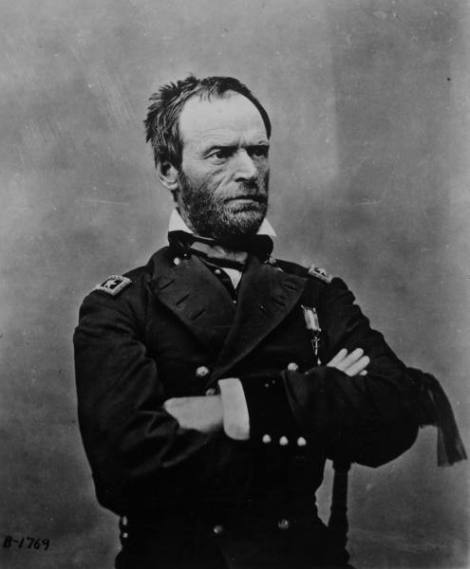
“You cannot qualify war in harsher terms than I will. War is cruelty, and you cannot refine it. You might as well appeal against the thunderstorm as against these terrible hardships of war. They are inevitable, and the only way the people of Atlanta can hope once more to live in peace and quiet at home, is to stop the war, which can only be done by admitting that it began in error and is perpetuated in pride.”
– William Tecumseh Sherman
Steven E. Woodworth’s perceptive Sherman is a slender 178-page volume that attains its objective of providing a concise and quintessential overview of the life and military leadership of one of America’s greatest generals, William Tecumseh Sherman.
Sherman: Lessons in Leadership is one among a number of volumes in the Great Generals Series of Palgrave MacMillan, which also includes biographies of Ulysses S. Grant, Robert E. Lee, Douglas MacArthur, George C. Marshall, Stonewall Jackson and others. It is a lucid, well-written and perspicuous assessment of Sherman’s part in the great events of 19th century America. Woodworth’s narrative is fluid, and he consistently maintains the readers interest from start to finish. I heartily recommend this little volume to any who are curious about the life and times of this great combat leader.
A Brief Excerpt
“Sherman’s decision to rest his troops after the fall of Atlanta was to become the object of much future criticism. He may have passed up an opportunity to destroy or capture the main Rebel army in the West, although such feats were notoriously rare during the Civil War. Had Grant been in Sherman’s place, he would undoubtedly have made the attempt, but in that respect Grant was simply a better general than Sherman or any other general of the Civil War. Sherman excelled in other aspects of generalship. Though he was less likely than Grant to eliminate an enemy army, Sherman was to show that he could conceive of other, less costly, ways of winning the war.
“The failure to trap Hood’s army after the fall of Atlanta revealed how Sherman tended to focus on different objectives than Grant did. Grant aimed at the destruction of the enemy armies, while Sherman thought in terms of taking or destroying key strategic objectives that would undercut the enemy’s ability to sustain its armies. Thus, two days after the fall of Atlanta, he wrote to Halleck that there would be no point in advancing against Hood now, because ‘there is no valuable point to his rear till we reach Macon,’ and it was at present impractical to start a campaign against that city. For Grant, the object of advancing against one of the enemy’s strategic points was chiefly to induce the enemy to come out and fight, whereas for Sherman there was no reason to move against the enemy’s army if not for the purpose of taking one of his strategic points. Both approaches were sensible.
“Sherman had also displayed weaknesses in assuming his enemy would do what Sherman hoped he would do – such as evacuating Atlanta – and in misreading his enemy’s intentions – as in his failure to anticipate Hood’s attacks at the battles of Atlanta and Ezra Church. In those cases, the foresight of his younger lieutenants McPherson and Howard had prevented at least a serious check to one component of Sherman’s force. Throughout the war, Sherman had difficulty in calculating what the enemy was doing outside of the range of his direct observation. By this point in the conflict, however, he had learned to surround himself with such outstanding subordinates as Howard and McPherson and to listen to their concerns. Sherman had indeed come a long way since Shiloh.
“The capture of Atlanta was just the sort of tangible accomplishment the Northern public needed in order to grasp that the war was not, as Democratic Party orators were telling them, a failure, but that in fact victory was on its way if only the Union remained resolute. Lincoln might perhaps have won reelection without Sherman’s victory at Atlanta – though Lincoln himself thought it unlikely – but the success of the campaign did more than any other single event to insure Lincoln’s victory and a reaffirmation of the North’s determination to see the war through to final victory for the Union and for emancipation. In that sense, it deserves to be counted as one of the most decisive battles of the war.
“Throughout the campaign, Sherman had practiced maneuver warfare more skillfully and on a wider stage than any other Civil War general had done. Only at Kennesaw Mountain had he made the mistake of attacking where Johnston wanted him to attack. On every other occasion Sherman’s main effort had taken his forces around Johnston’s strength to strike at vulnerable areas the Confederate general had left uncovered. Every Civil War army commander attempted to execute turning movements, but Sherman showed himself to be the master of such maneuvers. Again and again, he successfully turned his opponents, leaving them the unenviable options of retreating or fighting at a disadvantage. Johnston consistently chose retreat. Hood, just as characteristically, chose to fight. The results, ultimately, were the same. The fundamental concepts Sherman had used – maneuvering, avoiding enemy strength, capitalizing on enemy weaknesses – transcend muzzle-loading rifles and black-powder artillery and are as valid in the twenty-first century as they were in the nineteenth.”

No comments:
Post a Comment